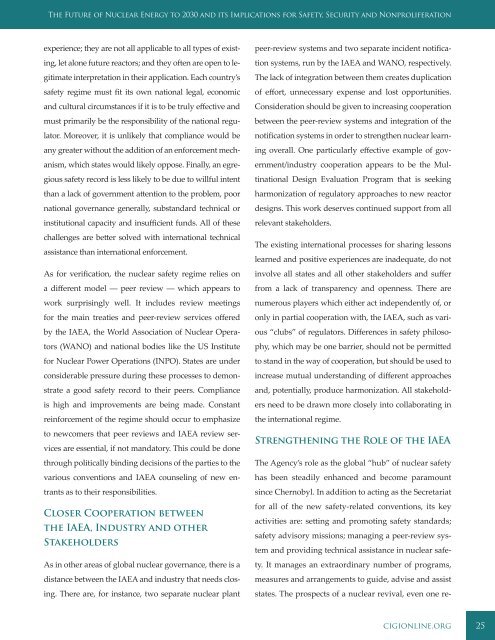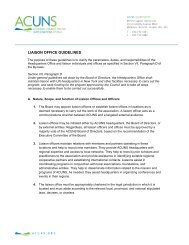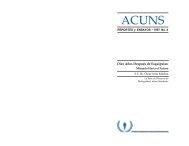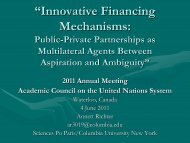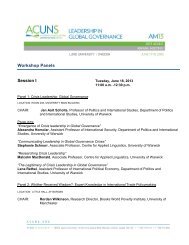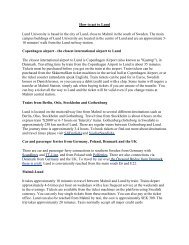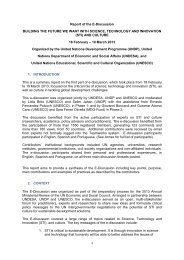THE FUTURE OF NUCLEAR ENERGY TO 2030 AND ITS ... - acuns
THE FUTURE OF NUCLEAR ENERGY TO 2030 AND ITS ... - acuns
THE FUTURE OF NUCLEAR ENERGY TO 2030 AND ITS ... - acuns
You also want an ePaper? Increase the reach of your titles
YUMPU automatically turns print PDFs into web optimized ePapers that Google loves.
The Future of Nuclear Energy to <strong>2030</strong> and its Implications for Safety, Security and Nonproliferation<br />
experience; they are not all applicable to all types of existing,<br />
let alone future reactors; and they often are open to legitimate<br />
interpretation in their application. Each country’s<br />
safety regime must fit its own national legal, economic<br />
and cultural circumstances if it is to be truly effective and<br />
must primarily be the responsibility of the national regulator.<br />
Moreover, it is unlikely that compliance would be<br />
any greater without the addition of an enforcement mechanism,<br />
which states would likely oppose. Finally, an egregious<br />
safety record is less likely to be due to willful intent<br />
than a lack of government attention to the problem, poor<br />
national governance generally, substandard technical or<br />
institutional capacity and insufficient funds. All of these<br />
challenges are better solved with international technical<br />
assistance than international enforcement.<br />
As for verification, the nuclear safety regime relies on<br />
a different model ― peer review ― which appears to<br />
work surprisingly well. It includes review meetings<br />
for the main treaties and peer-review services offered<br />
by the IAEA, the World Association of Nuclear Operators<br />
(WANO) and national bodies like the US Institute<br />
for Nuclear Power Operations (INPO). States are under<br />
considerable pressure during these processes to demonstrate<br />
a good safety record to their peers. Compliance<br />
is high and improvements are being made. Constant<br />
reinforcement of the regime should occur to emphasize<br />
to newcomers that peer reviews and IAEA review services<br />
are essential, if not mandatory. This could be done<br />
through politically binding decisions of the parties to the<br />
various conventions and IAEA counseling of new entrants<br />
as to their responsibilities.<br />
Closer Cooperation between<br />
the IAEA, Industry and other<br />
Stakeholders<br />
As in other areas of global nuclear governance, there is a<br />
distance between the IAEA and industry that needs closing.<br />
There are, for instance, two separate nuclear plant<br />
peer-review systems and two separate incident notification<br />
systems, run by the IAEA and WANO, respectively.<br />
The lack of integration between them creates duplication<br />
of effort, unnecessary expense and lost opportunities.<br />
Consideration should be given to increasing cooperation<br />
between the peer-review systems and integration of the<br />
notification systems in order to strengthen nuclear learning<br />
overall. One particularly effective example of government/industry<br />
cooperation appears to be the Multinational<br />
Design Evaluation Program that is seeking<br />
harmonization of regulatory approaches to new reactor<br />
designs. This work deserves continued support from all<br />
relevant stakeholders.<br />
The existing international processes for sharing lessons<br />
learned and positive experiences are inadequate, do not<br />
involve all states and all other stakeholders and suffer<br />
from a lack of transparency and openness. There are<br />
numerous players which either act independently of, or<br />
only in partial cooperation with, the IAEA, such as various<br />
“clubs” of regulators. Differences in safety philosophy,<br />
which may be one barrier, should not be permitted<br />
to stand in the way of cooperation, but should be used to<br />
increase mutual understanding of different approaches<br />
and, potentially, produce harmonization. All stakeholders<br />
need to be drawn more closely into collaborating in<br />
the international regime.<br />
Strengthening the Role of the IAEA<br />
The Agency’s role as the global “hub” of nuclear safety<br />
has been steadily enhanced and become paramount<br />
since Chernobyl. In addition to acting as the Secretariat<br />
for all of the new safety-related conventions, its key<br />
activities are: setting and promoting safety standards;<br />
safety advisory missions; managing a peer-review system<br />
and providing technical assistance in nuclear safety.<br />
It manages an extraordinary number of programs,<br />
measures and arrangements to guide, advise and assist<br />
states. The prospects of a nuclear revival, even one re-<br />
cigionline.org 25


